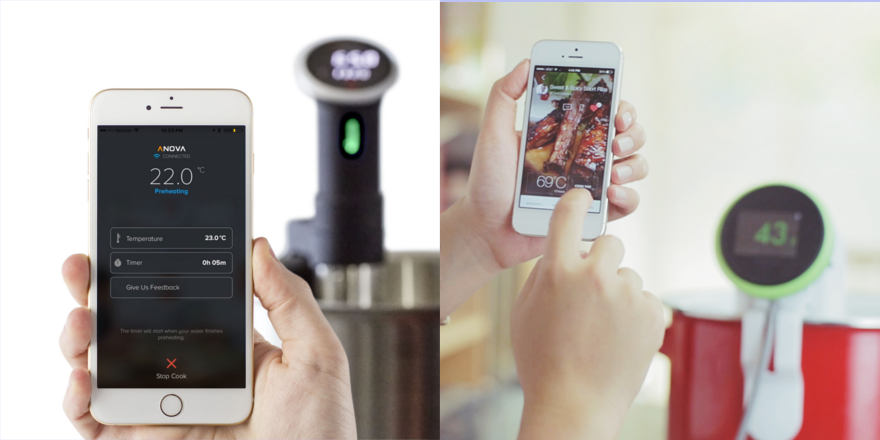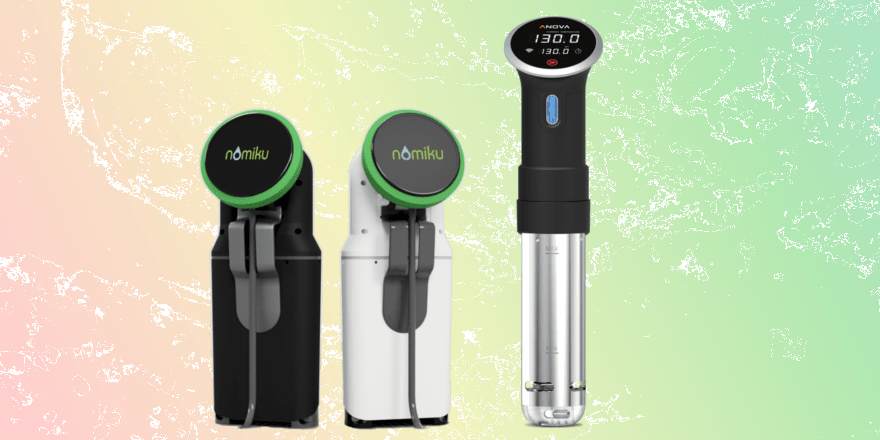Sous vide cooking offers an easy and convenient way to get high-quality results each and every time. By meticulously controlling the temperature of a water bath, immersion circulators allow chefs to cook food consistently using vacuum sealed bags. These gadgets are relatively new, but have quickly taken the cooking world by storm with a foolproof approach to quality cooking. If you’re into both food and tech, sous vide cooking is a perfect combination of both worlds.
This comparison and review takes a look at the Nomiku vs. Anova Bluetooth + WiFi, two immersion circulators that offer easy access to consistently great food. Let’s take a look at some of the major differences between the two and try to get a sense of which product is more right for you.
Nomiku vs. Anova — Differences
-
Difference #1: Design – There are some differences between the Nomiku and Anova in their design as well as the way they clip to the pot.
The Anova features a digital display that gives the target temperature, current temperature, and remaining cooking time. The circulator is controllable both through a manual dial and a smartphone app. The device attaches to a pot using a versatile clamp, and will work on pretty much any container with adequate depth.
A unique front-facing clip keeps the Nomiku securely in place on the edge of any pot at least six inches in height. While not as sturdy as a the turn clamp on the Anova, it definitely stays in place and shouldn’t give you any issues when setting up your sous vide container.
The Nomiku features a 2.4″ LCD screen with two different buttons: the menu button pulls up an option menu, and the action button selects said options. Another cool feature of the Nomiku is the trademark fluorescent green often found in their branding. It gives the device a beautiful and unique aesthetic.
Functionally, there’s been talk of the selection wheel being a little clunky. Some have found that one click of the wheel caused the menu selector to jump two positions. This isn’t a dealbreaker, but certainly sounds a bit frustrating.
-
Difference #2: Heat Power – The Nomiku has more power, which lends itself to a speedier preheating process. The Nomiku is 1100 watts vs the Anova’s 900, the Nomiku took around 16 minutes to heat water from 75F to 135F. Conversely, the Anova took about 24 minutes to do the same task!
Overall, the Nomiku is the better choice if time is a major concern.
-
Difference #3: Detachable Cord – One big perk to the Anova circulator is the detachable power cord. Being able to remove the cord makes cleaning and general maintenance a lot easier, and this is a notable advantage over the Nomiku.
While definitely not unique in the inability to detach the cord, it’s still unfortunate that this feature isn’t present with the Nomiku.
-
Difference #4: Circulation Capacity – The Nomiku has a 1.8 gallon (7 L) per minute circulation rate, while the Anova circulates 2.4 gallons (9 L). In terms of container capacity, the Nomiku comes out on top with an 8+ gallon (30 L) capacity compared to the Anova’s 5.8 gallons (22 L)
There isn’t a clear winner in this section, with Nomiku coming out ahead with a higher container capacity and the Anova circulating faster.
-
Difference #5: Plug Configuration – Currently, the Nomiku is only compatible with US plugs. International users (240V) should pre-order a compatible model for delivery (will update this detail as more info comes out).
The Anova, on the other hand, is much more compatible, having support for 120v USA/CA, 220v AU, 220v EU/Korea, and 220v UK plugs.
-
Difference #6: Bluetooth – The Anova has an advantage in connectivity with the ability to connect via Bluetooth, while the Nomiku only supports Wi-Fi.
Practically, this functionality won’t make a huge difference in the long run. Chances are that you’re at home when using the sous vide cooker, and access to Wi-Fi will likely not be an issue. Still, Bluetooth offers an additional option on the off chance that your internet connection is spotty.
-
Difference #7: Connectivity – The Anova definitely has the upper hand when it comes to smart home integration, with support for both Amazon Alexa and Google Home. Being able to control your sous vide circulator with simple voice commands isn’t crucial, but it’s definitely an appreciated convenience.
The Nomiku, on the other hand, offers no support for smart homes at all.
Nomiku vs. Anova — Comparison Table
| Anova WiFi | Nomiku | |
|---|---|---|
| Display Control | LCD Display LED back-lit scroll wheel |
LCD Touch Screen Selection Knob |
| Control Type | Manual Anova App |
Manual Tender App |
| Width | 2.75 Inches | 4.0 Inches |
| Height | 14.75 Inches | 12.0 Inches |
| Weight | 2.5 lbs | 4.8 lbs |
| Auto Shut-off | Yes | Yes |
| Power | 900 Watts | 1100 Watts |
| Maximum Temperature | 210°F | 203°F |
| Minimum Fill | 2.75 Inches | 1.5 Inches |
| Maximum Fill | 6.25 Inches | 5.5 Inches |
| Type of Clip | Adjustable Ring Clip | Front-Facing Clip |
| App | iOS 9.0 or later for Wi-Fi, Android 4.3 and later | iOS, Android, Windows, Chrome |
| Power Input Options | 120v USA/CA 220v AU 220v EU/Korea 220v UK |
120v USA/CA 220v EU/Korea (Pre-order) |
| Works with Amazon Alexa | Yes | No |
| Works with Google Home | Yes | No |
Nomiku vs. Anova — Our Thoughts

At the end of the day, either immersion circulator will get the job done. The Anova offers more comprehensive remote control options via bluetooth, app connectivity, and smart home controllers. The Nomiku offers less quality of life features and is a lot bigger and heavier, but it packs significantly more power, leading to quicker and more effective cooking.
We’ve done our best to go over the benefits and drawbacks of each model. With this information in hand, the choice of which sous vide cooker is the one for you is ultimately yours. No matter the decision, you’ll be experiencing the latest in culinary technology, allowing you to elevate your cooking to the next level.
Want to see how other sous vide machines stack up? Check out our Compare Sous Vide page.
Last update on 2024-04-19 at 14:59 / Affiliate links / Images from Amazon Product Advertising API



